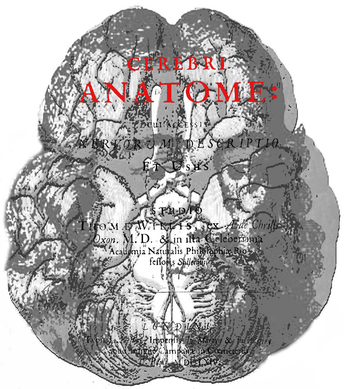Thomas Willis1621–1675
Thomas Willis and his circle of anatomists at Oxford pursued the examination of the brain rather than relying solely on the tracts of others. His Cerebri Anatome, published in 1664, placed dissections of the brain on firmer foundations: he numbered the cranial nerves and described the arterial circle at the base of the brain which still bears his name. In Willis’s images the anatomy of brain circumvolutions, sulci and scissurae are much more clearly defined than in Vesalius. Willis is shown enclosed within the diagram of the brain (drawn by Christopher Wren) taken from his Cerebri Anatome, together with its title page. In the same year that Descartes’ Traité was published, Willis established that the optic nerves projected to the optic thalami (rather than the pineal body), although the distinction between the thalami and the striate cortex had not been made at that time. The term ‘neurology’ was coined in the book and he pursued instances of its abnormalities. In his treatise on animal spirits (De Anima Brutorum, 1672) he defined and provided a putative interpretation of vertigo: it was “an affection in which visible objects appear to rotate”, and he devoted a chapter to its pathology and the conditions that can induce it in healthy individuals, including body rotation. He suggested that: “Vertigo arises from the circular motion of the spirits, and, as it were, their rotations in the brain and its medullary part. It takes place just as smoke and vapour contained in a glass or phial are sent into similar motion if you spin the vessel round. This motion lasts longer in the smoke or vapour than in the vessel. Thus we find people whose spirits are very thin, and therefore flexible and weak, pass into vertigo as soon as the body or head is rotated and this sensation persists after the body has ceased its turning motion”. Willis later worked in London and was one of the founder members of the Royal Society.
